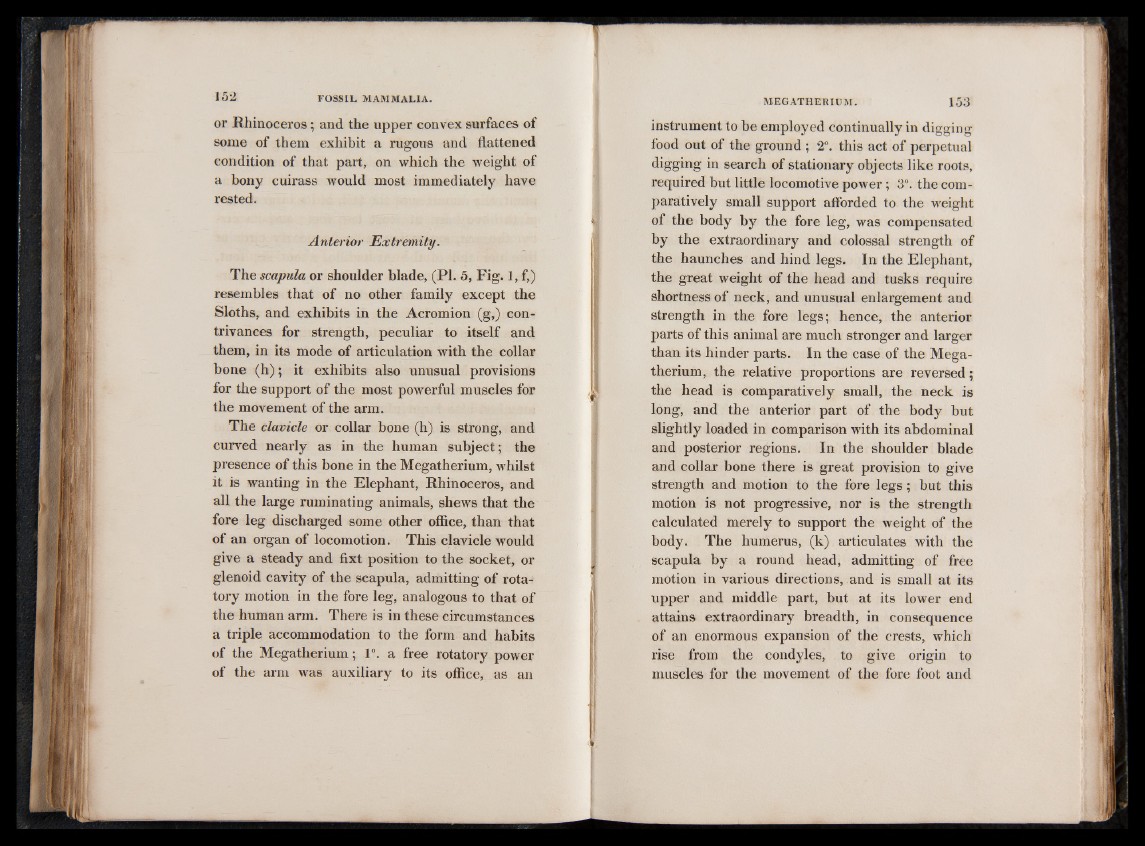
or Rhinoceros; and the upper convex surfaces of
some of them exhibit a rugous and flattened
condition of that part, on which the weight of
a bony cuirass would most immediately have
rested.
Anterior Extremity.
The scapula or shoulder blade, (PI. 5, Fig. 1, f,)
resembles that of no other family except the
Sloths, and exhibits in the Acromion (g,) contrivances
for strength, peculiar to itself and
them, in its mode of articulation with the collar
bone (h); it exhibits also unusual provisions
for the support of the most powerful muscles for
the movement of the arm.
The clavicle or collar bone (h) is strong, and
curved nearly as in the human subject; the
presence of this bone in the Megatherium, whilst
it is wanting in the Elephant, Rhinoceros, and
all the large ruminating animals, shews that the
fore leg discharged some other office, than that
of an organ of locomotion. This clavicle would
give a steady and fixt position to the socket, or
glenoid cavity of the scapula, admitting of rotatory
motion in the fore leg, analogous to that of
the human arm. There is in these circumstances
a triple accommodation to the form and habits
of the Megatherium; 1°. a free rotatory power
of the arm was auxiliary to its office, as an
instrument to be employed continually in digging
food out of the ground ; 2°. this act of perpetual
digging in search of stationary objects like roots,
required but little locomotive power; 3°. the comparatively
small support afforded to the weight
of the body by the fore leg, was compensated
by the extraordinary and colossal strength of
the haunches and hind legs. In the Elephant,
the great weight of the head and tusks require
shortness of neck, and unusual enlargement and
strength in the fore legs; hence, the anterior
parts of this animal are much stronger and larger
than its hinder parts. In the case of the Megatherium,
the relative proportions are reversed;
the head is comparatively small, the neck is
long, and the anterior part of the body but
slightly loaded in comparison with its abdominal
and posterior regions. In the shoulder blade
and collar bone there is great provision to give
strength and motion to the fore legs; but this
motion is not progressive, nor is the strength
calculated merely to support the weight of the
body. The humerus, (k) articulates with the
scapula by a round head, admitting of free
motion in various directions, and is small at its
upper and middle part, but at its lower end
attains extraordinary breadth, in consequence
of an enormous expansion of the crests, which
rise from the condyles, to give origin to
muscles for the movement of the fore foot and